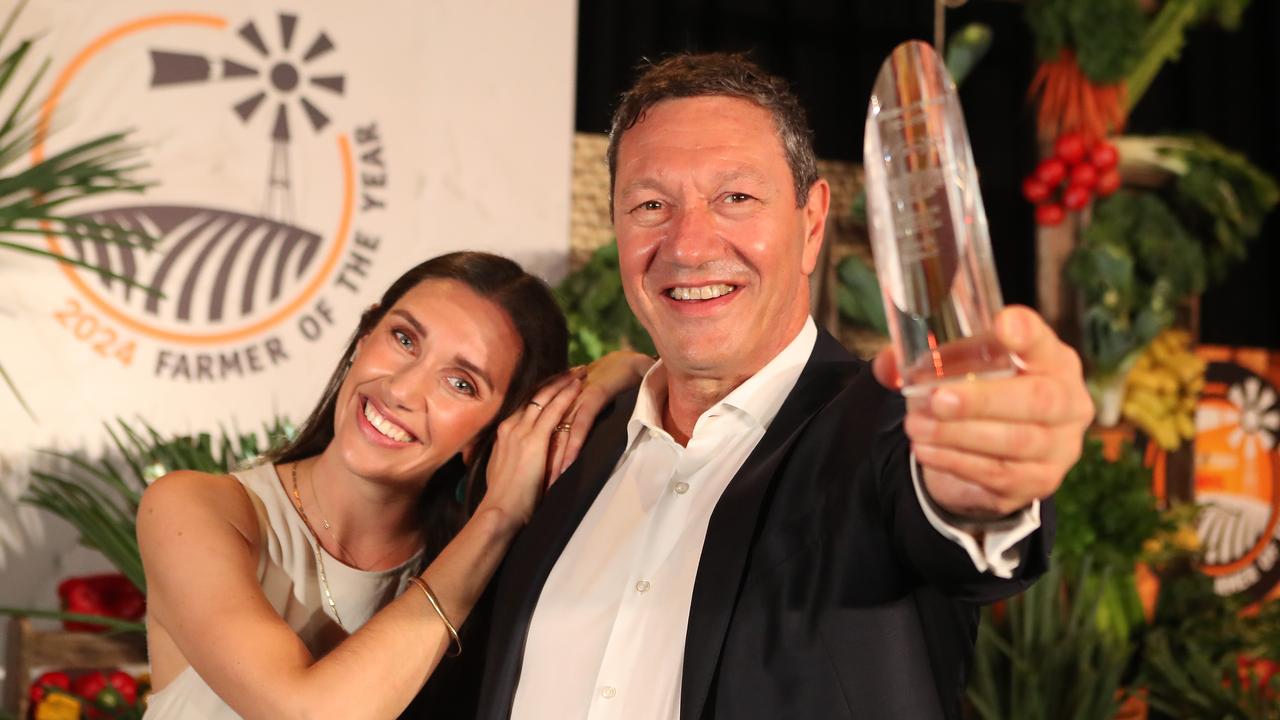Faithfulls Creek paddock-to-plate lamb brand takes off
Suzanne and Jim Gall made the gutsy move to kick start a paddock-to-plate lamb operation during the pandemic. See how they launched their branded business and why it’s thriving.
LAUNCHING a paddock-to-plate lamb business is one thing. Doing it at the height of a pandemic is something else entirely.
But for corporates-turned-farmers Suzanne and Jim Gall, a bold move to venture down the value-adding path in the middle of one of the worst health and economic crises in history is paying healthy dividends.
The Galls, who run more than 2000 Merino and Crossbred ewes across 768ha at Balmattum near Euroa in Victoria’s North East, launched the Faithfulls Creek Lamb brand in March, shortly after the first wave of COVID-19 prompted authorities to shut down pubs and restaurants across the nation in an attempt to curb its spread – forcing most businesses into either a holding pattern or retreat.
For the Galls it was the realisation of a long-held dream of producing their own branded product.
Jim grew up on his family’s property near Balmattum and during decades working in corporate roles in Melbourne returned home to the farm most weekends.
In 2013, when an opportunity arose to purchase a block neighbouring the family farm, on the banks of the Faithfulls Creek, Suzanne and Jim jumped at it.
“I felt that draw back to the land,” Jim said.
“And it was at that point in 2013 that we thought we would love to produce our own lamb and sell it direct. This was our ambition from day one but it really took us until 2020 to get it off the ground.
“COVID was the moment where we thought ‘let’s do this’. Everyone else was making great money but we weren’t and we didn’t know where our product was going or what it really tasted like. Now we control the entire supply chain, from farm to transport to butcher and to consumer with full traceability.”
For Suzanne, it’s the human connection the brand has fostered over the past six months that has stood out.
“Getting to know our consumers has really been the best thing,” she said.
“They want to know where their product is coming from and want to know our story. They are so fascinated by the management and traceability of our lamb.
“We have some customers now who are up to their fifth order”.
BRAND STAND
JIM and Suzanne are the fifth generation of the Galls to farm around Euroa – and their 16-year-old twin daughters Olivia and Georgia are the sixth. Both have studied agriculture at school and lend a hand with chores such as lamb marking and shearing.
And because they’re the consumer of the future, Suzanne and Jim say their views are a huge benefit.
“They keep you honest and grounded in respect to production practices, which is a very important part,” Suzanne said.
“Agriculture industry needs to listen to the youth and their views around sustainability and animal welfare. They are a hidden benefit really – they want to know how we manage the livestock, the use of dogs, small mobs and twinning and the management of water ways and planting trees.”
The couple have also drawn inspiration for their business from New Zealand, where they spent two years working prior to the pandemic.
“It was a really stimulating and creative place. We saw a lot of innovation particularly around value adding beyond the farm gate. It was really inspiring and they really believe in themselves,” Suzanne said. “It inspired us to have the confidence to be able to say, let’s just try it.”
With Jim still working full-time in the corporate world – farming at weekends – Suzanne runs the property and lamb brand with the help of experienced farm manager Andrew Hill.
The Galls are currently working towards running 2400 ewes, producing White Suffolk-Merino lambs, which are free range and milk and pasture fed. Suzanne said while the land could carry a lot more stock, they aimed to graze conservatively and “don’t want to be under pressure to finish stock in difficult conditions.”
SELF CENTRED
THE flock is part self-replacing, with additional sheep bought in as required. Merino bloodlines are derived from West Australian studs, with White Suffolks purchased originally from the Wattle Park White Suffolk flock at Finley in NSW.
Jim said one of the best things the couple had invested in was electronic identification equipment, which meant they could trace every animal on the farm and gather information such as ewe conception and lamb survival rates to assist with selection of genetics, along with monitoring weight gains in their lambs.
“We aim to breed robust ewes with plenty of length, that are able to lamb well,” Jim said. “Our winters do get cold and summer hot, so we want an animal that can stand up to all of that.”
The Galls have had a great season, having already had 80 per cent of their 700mm annual average.
“We had early autumn rain and winter rain and we hadn’t been getting that in recent years,” Jim said. “Typically we have been getting dryish winters and springs and then oddly, more rainfall into the summer months.
“It’s more back to what it was in the ‘80s with a good autumn.”
Joining usually takes place in November for an autumn lambing with a second joining this year in February to shore up supply. Lambs are grown out and finished by October, November and December, although the Galls say finishing will be stretched out longer to meet lamb orders for at least 8 months of the year. Lamb survival rates vary from about 105 per cent for Merino ewes to 130 per cent for crossbreds.
Paddocks are 30-40ha in size with stock regularly rotated through sown down multi-species pastures and lucerne crops.
Lambs are kept with their mothers for as long as possible.
“We let them naturally wean off their mother, which is another key factor in producing super tasty lamb,” she said.
TASTE TEST
WHILE some might scoff at a White Suffolk-Merino lamb Suzanne said all their own research had proved its worth. Before launching the business, the Galls did a lot of work with consumers on “flavour, tenderness and overall appeal”.
“What we have found is that the eating quality of a White Suffolk over a Merino delivers a really beautiful, full flavoured tender lamb,” Suzanne said.
“Historically, everyone has been of the view that it is a Dorset or a White Suffolk over a crossbred ewe. That will get you a lamb that gets fat quickly but the tasting profiling with consumers, and the work we have done with butchers, has found that they actually love the quality Merino-cross lamb.
“It is far superior and a better-flavoured product.”
Jim said prior to launching their own brand, their marketing options were “so controlled” with very few options other than selling stock through saleyards, or direct to processors.
“We would put them on the truck, sometimes travelling long distances and we got what we got at market,” he said. “We would dread that phone call from the agent telling us the market was down this week.”
Supplying lamb all year round as opposed to a three or four-month period is a different strategy,” Suzanne said. “Now our challenge is making sure we have enough lambs to keep up with supply.”
TIME’S RIGHT
JIM said the way their business was now run, when the lambs were ready to go, they went.
Lambs are slaughtered at an abattoir a 40-minute drive away at Wangaratta.
“It’s a stress-free environment and they are actually very calm, there are no other people around,” he said.
The Galls sell their lambs via their Faithfulls Creek Lamb website and since launching just six months ago orders have tripled. A whole lamb, weighing 20-23kg, sells for $350 and a half lamb, 10-12kg, fetches $195.
Jim and Suzanne say at that price they’ve more than doubled their return and the consumer was paying no more than $14-$16/kg. Orders are delivered across Melbourne and regional Victoria every fortnight.
When it comes to marketing, the Galls use social media, search-engine marketing, local produce markets and word of mouth to spread their story. They say one of the best parts about the brand is the interaction they have with consumers.
Suzanne said she encouraged first-time buyers to start with a half lamb and added it wasn’t long before they would send photos of their meals and recipes.
“It’s about enjoying the experience and we want to do everything for that consumer,” she said.
“I think we are going through a period of humanity where things are less corporate, more authentic and more about dealing with real people.”
While setting up the business was far from easy the Galls say one of the easiest steps was their website. “The technology that is out there is amazing,” Suzanne said.
“You can build a website, a brand, and be trading for $29 a month – all within a few days.”
It’s a rise to the top of the chops that makes dollars and sense.
MORE
JILLAMATONG LAMB: WALDRON FAMILY’S BRAND PARTNERSHIP WITH COROWA IGA
MAKE SHEEP FARMING ‘COOL’ FOR NEXT GENERATION, SAYS JAMIE HEINRICH
DUNCAN AND JESS BARBER NAMED THE WEEKLY TIMES COLES 2019 SHEEP FARMER OF THE YEAR


